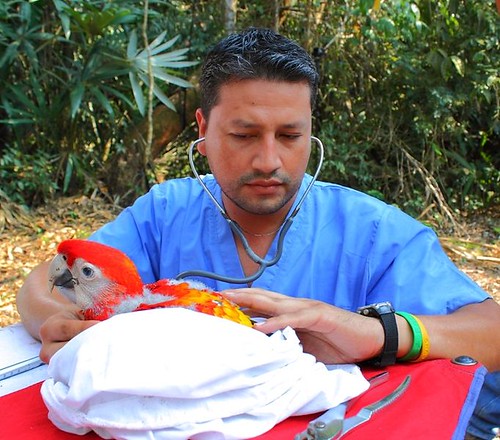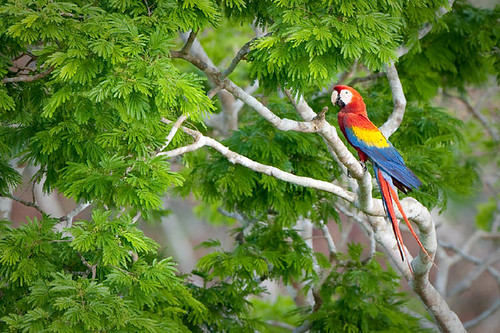 Melvin Merida, a field veterinarian for the Wildlife Conservation Society’s Guatemala Program performs a medical checkup on a wild macaw chick in the Maya Biosphere Reserve. Credit: WCS Guatemala ProgramProgram posts record number of parrot fledglings in 2011
Melvin Merida, a field veterinarian for the Wildlife Conservation Society’s Guatemala Program performs a medical checkup on a wild macaw chick in the Maya Biosphere Reserve. Credit: WCS Guatemala ProgramProgram posts record number of parrot fledglings in 2011
Researchers and conservationists from the Wildlife Conservation Society's Guatemala Program, WCS's Bronx Zoo, the National Park Service of Guatemala, and other groups report a major conservation victory from Central America: a bumper crop of magnificent scarlet macaw fledglings that have now taken flight over the forests of Guatemala.
 A pair of scarlet macaws in flight over the forests of Guatemala. Credit: WCS Guatemala Program. Credit: WCS Guatemala ProgramThe newly fledged birds total 29 macaws, a big success for conservationists working in the Maya Biosphere Reserve who were hoping to record at least one fledgling from each monitored nest (24 nests in total) during the 2011 season. The monitoring program focused on helping weak and at-risk chicks—some of which were removed from tree cavity nests and hand-reared in a jungle hospital—with guidance from the Bronx Zoo's Department of Ornithology and veterinarians from the Global Health Program. The rehabilitated chicks were then fostered back in nests with chicks of the same age, a procedure that greatly increased the chances of survival for these rare birds.
A pair of scarlet macaws in flight over the forests of Guatemala. Credit: WCS Guatemala Program. Credit: WCS Guatemala ProgramThe newly fledged birds total 29 macaws, a big success for conservationists working in the Maya Biosphere Reserve who were hoping to record at least one fledgling from each monitored nest (24 nests in total) during the 2011 season. The monitoring program focused on helping weak and at-risk chicks—some of which were removed from tree cavity nests and hand-reared in a jungle hospital—with guidance from the Bronx Zoo's Department of Ornithology and veterinarians from the Global Health Program. The rehabilitated chicks were then fostered back in nests with chicks of the same age, a procedure that greatly increased the chances of survival for these rare birds.
 Caption: A scarlet macaw adult visits its nest in the Maya Biosphere Reserve in Guatemala. Credit: WCS Guatemala Program"The success in increasing the nesting success of scarlet macaws through intensive chick management and fostering is a great step forward for macaw conservation," said WCS Conservationist Rony Garcia. "We believe the lessons learned can not only help save the scarlet macaw in Guatemala, but be extended to help other threatened species of parrots and cavity nesters across the globe."
Caption: A scarlet macaw adult visits its nest in the Maya Biosphere Reserve in Guatemala. Credit: WCS Guatemala Program"The success in increasing the nesting success of scarlet macaws through intensive chick management and fostering is a great step forward for macaw conservation," said WCS Conservationist Rony Garcia. "We believe the lessons learned can not only help save the scarlet macaw in Guatemala, but be extended to help other threatened species of parrots and cavity nesters across the globe."
With a total estimated population of some 300 macaws in the country, each successfully fledged bird is critical for the survival of the species. The bumper crop of fledglings in the 2011 season stands in stark contrast to the 2003 season that registered only one fledgling from 15 nests.
Monitoring scarlet macaw nests is not for the faint of heart. Researchers need to be able to climb trees (often with the aid of rappelling lines up to 30 meters above the canopy floor) to inspect nests, mount video cameras, and sometimes remove sick chicks from the nesting cavities. Researchers from WCS's Guatemala Program received key off-site assistance from Dr. Nancy Clum, Curator of Ornithology at WCS's Bronx Zoo, who provided guidance in the care of the at-risk chicks, and Drs. Bonnie Raphael and Robert Moore of WCS's Global Health Program, who provided health screening for pathogens.
 Researchers and conservationists from the Wildlife Conservation Society and other groups have helped to raise a bumper crop of scarlet macaw fledglings in the forests of Guatemala, where the species has become threatened by a combination of habitat destruction and poaching for the pet trade. Credit: WCS Guatemala ProgramWCS has been working to conserve the scarlet macaw—one of the world's largest parrot species—since 2001, protecting the species from habitat destruction and poaching for the pet trade. WCS also works to strengthen government capacity for enforcement, particularly in Maya Biosphere Reserve, where an estimated 95 percent of scarlet macaws in the country live and nest, and support local communities that protect macaw habitat in forest concessions.
Researchers and conservationists from the Wildlife Conservation Society and other groups have helped to raise a bumper crop of scarlet macaw fledglings in the forests of Guatemala, where the species has become threatened by a combination of habitat destruction and poaching for the pet trade. Credit: WCS Guatemala ProgramWCS has been working to conserve the scarlet macaw—one of the world's largest parrot species—since 2001, protecting the species from habitat destruction and poaching for the pet trade. WCS also works to strengthen government capacity for enforcement, particularly in Maya Biosphere Reserve, where an estimated 95 percent of scarlet macaws in the country live and nest, and support local communities that protect macaw habitat in forest concessions.
"With 10 years of effort, we have succeeded in developing an effective mix of interventions that will ensure the long-term persistence of the scarlet macaw in Guatemala," said Dr. Julie Kunen, Director of WCS's Latin America and Caribbean Program.
Roan McNab, Director of WCS's Guatemala Program, said: "Our current challenge is to maintain these interventions until we see a significant increase in the number of active nests within the Maya Biosphere Reserve landscape."
The scarlet macaw project benefits from the support of USAID, BBC Wildlife Fund, the American Museum of Natural History, and LeFebre Conservation, among others.